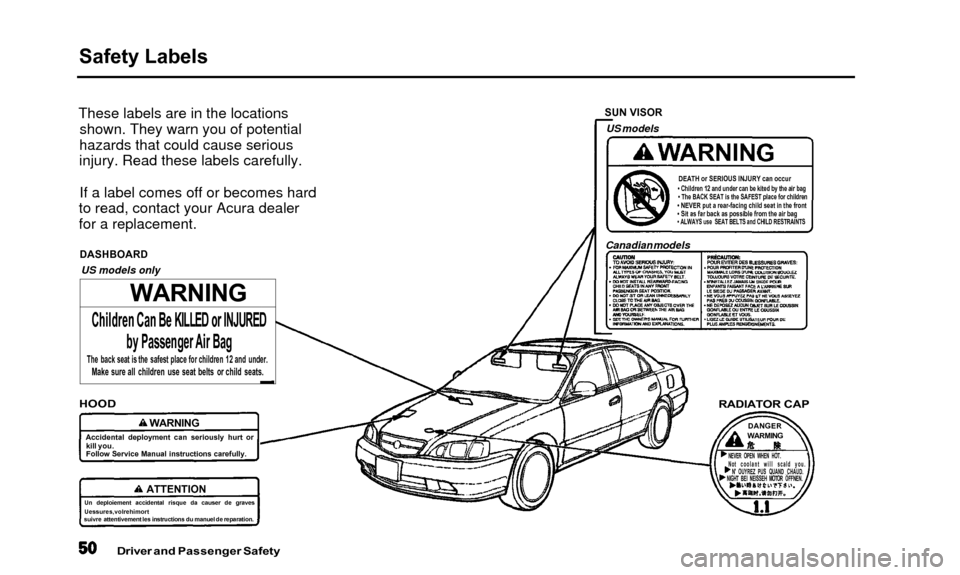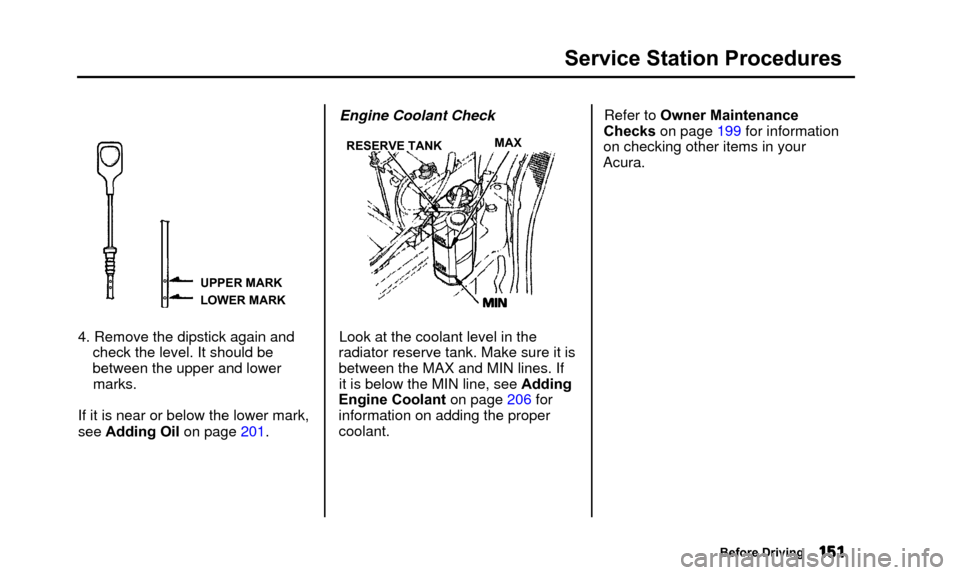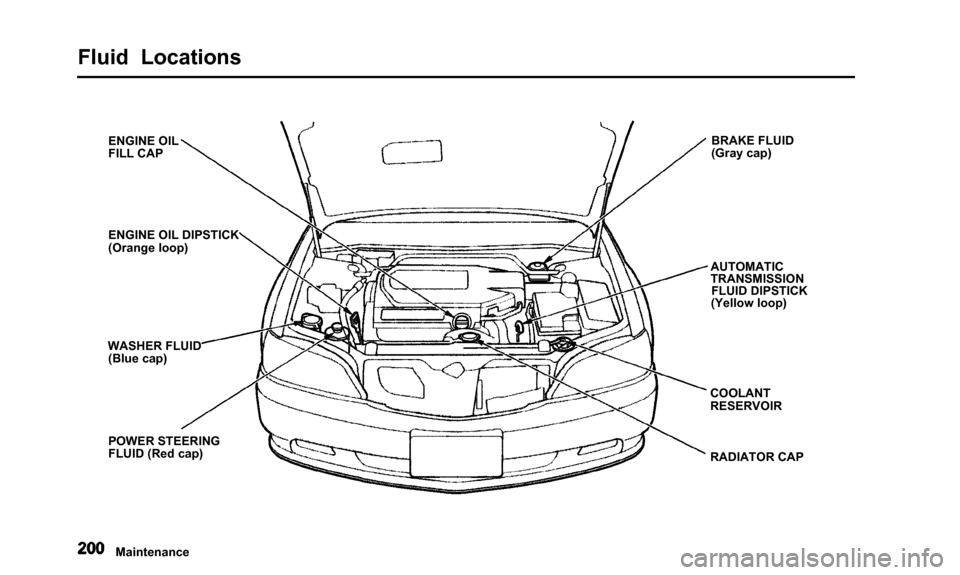radiator Acura TL 2000 3.2 Owner's Manual
[x] Cancel search | Manufacturer: ACURA, Model Year: 2000, Model line: TL, Model: Acura TL 2000Pages: 311, PDF Size: 3.05 MB
Page 53 of 311

Safety Labels
These labels are in the locationsshown. They warn you of potential
hazards that could cause serious
injury. Read these labels carefully.
If a label comes off or becomes hard
to read, contact your Acura dealer
for a replacement.
DASHBOARD
US models only SUN VISOR
US models
DEATH or SERIOUS INJURY can occur• Children 12 and under can be kited by the air bag• The BACK SEAT is the SAFEST place for children
• NEVER put a rear-facing child seat in the front
• Sit as far back as possible from the air bag
• ALWAYS use SEAT BELTS and CHILD RESTRAINTS
Canadian models
HOOD
Accidental deployment can seriously hurt or
kill you.
Follow Service Manual instructions carefully.
Un deploiemen t accidental risque da causer de graves
Uessures,volrehimort
suivre attentivemen t les instructions du manuel de reparation.
Driver and Passenger Safety
RADIATOR CAP
DANGERWARMING
NEVER OPEN WHEN HOT. '
Not coolant will scald you. N' OUYREZ PUS QUAND CHAUD.
NIGHT BEI NEISSEH MOTOR OFFNEN.
WARNING
Children Can Be KILLED or INJURED
by Passenger Air Bag
The back seat is the safest place for children 12 and under.Make sure all children use seat belts or child seats.
WARNING
ATTENTION
Page 154 of 311

Service Station Procedures
UPPER MARK
LOWER MARK
4. Remove the dipstick again andcheck the level. It should be
between the upper and lowermarks.
If it is near or below the lower mark,
see Adding Oil on page 201. Engine Coolant Check
RESERVE TANK
Look at the coolant level in the
radiator reserve tank. Make sure it is
between the MAX and MIN lines. If it is below the MIN line, see Adding
Engine Coolant on page 206 for
information on adding the proper coolant. Refer to Owner Maintenance
Checks on page 199 for information
on checking other items in your
Acura.
Before Driving
MAX
Page 202 of 311

Owner Maintenance Checks
You should check the followingitems at the specified intervals. If
you are unsure of how to perform any check, turn to the page given. • Engine oil level — Check every
time you fill the fuel tank. See
page 150.
• Engine coolant level — Check the radiator reserve tank every time
you fill the fuel tank. See page 151.
• Windshield washer fluid — Check the level in the reservoir monthly.If weather conditions cause you to
use the washers frequently, check
the reservoir each time you stop
for fuel. See page 212 .
• Automatic transmission — Check the fluid level monthly. See page213.
• Brakes — Check the fluid level monthly. See page 214 . • Tires — Check the tire pressure
monthly. Examine the tread for
wear and foreign objects. See page
229.
• Lights — Check the operation of the headlights, parking lights,
taillights, high-mount brake light,
turn signals, brake lights, and
license plate lights monthly. See
page 234.
Maintenance
Page 203 of 311

Fluid Locations
ENGINE OIL
FILL CAP
ENGINE OIL DIPSTICK
(Orange loop)
WASHER FLUID (Blue cap)
POWER STEERING
FLUID (Red cap) BRAKE FLUID
(Gray cap)
AUTOMATIC
TRANSMISSION FLUID DIPSTICK
(Yellow loop)
COOLANT
RESERVOIR
RADIATOR CAP
Maintenance
Page 209 of 311

Cooling System
Adding Engine Coolant
RESERVE TANK
If the coolant level in the reserve
tank is at or below the MIN line, add
coolant to bring it up to the MAX line.Inspect the cooling system for leaks.
This coolant should always be a mixture of 50 percent antifreeze and50 percent water. Never add straight
antifreeze or plain water. Always use Genuine Honda
Antifreeze/Coolant. If it is not
available, you may use another
major-brand non-silicate coolant as a
temporary replacement. Make sure it
is a high-quality coolant
recommended for aluminum engines.
However, continued use of any non-
Honda coolant can result in corrosion, causing the cooling
system to malfunction or fail. Have
the cooling system flushed and refilled with Honda antifreeze/
coolant as soon as possible. If the reserve tank is completely
empty, you should also check the
coolant level in the radiator.
Maintenance
Page 210 of 311

Cooling System
Removing the radiator cap
while the engine is hot can
cause the coolant to spray out,
seriously scalding you.
Always let the engine and radiator cool down beforeremoving the radiator cap.RADIATOR CAP
1. Make sure the engine and radiator
are cool.
2. Turn the radiator cap counter- clockwise, without pressing down
on it, until it stops. This relieves
any pressure remaining in the
cooling system. 3. Remove the radiator cap by
pushing down and turningcounterclockwise.
CONTINUED
Maintenance
Page 211 of 311

Cooling System
4. The coolant level should be up tothe base of the filler neck. Add
coolant if it is low.
5. Put the radiator cap back on. Tighten it fully.
RESERVE TANK
6. Pour coolant into the reserve tank. Fill it to halfway between the MAX
and MIN marks. Put the cap back on the reserve tank.
Do not add any rust inhibitors or other additives to your car's cooling
system. They may not be compatible
with the coolant or engine compo- nents. Replacing Engine Coolant
The cooling system should be completely drained and refilled with
new coolant according to the timeand distance recommendations in
the maintenance schedule. Only use Genuine Honda Antifreeze/Coolant.
Draining the coolant requires access
to the underside of the car. Unless
you have the tools and knowledge,
you should have this maintenance done by a skilled mechanic.
Maintenance
Page 212 of 311

Cooling System
1. Turn the ignition ON (II). Turnthe heater temperature controldial to maximum heat (climate
control to 90°F/32°C). Turn off
the ignition. Open the hood. Make sure the engine and radiator are
cool to the touch.
2. Remove the radiator cap.
DRAIN PLUG
DRAIN BOLT
3. Loosen the drain plug on thebottom of the radiator. Thecoolant will drain through thesplash guard. Loosen the drain
bolt at the rear of the engine cylinder block.
RESERVE TANK CAP RESERVE TANK
HOLDER
4. Remove the reserve tank from itsholder by pulling it straight up.Drain the coolant, then put the
tank back in its holder.
5. When the coolant stops draining, tighten the drain plug at the
bottom of the radiator.
CONTINUED
Maintenance
Page 213 of 311

Cooling System
6. Tighten the drain bolt at the rearof the engine cylinder blocksecurely.
Tightening torque: 7 Ibf-ft(10N-m,1.0kgf-m)
7. Mix the recommended antifreeze with an equal amount of purifiedor distilled water in a clean
container. The cooling system
capacity is:
1.48 US gal (5.6 i, 1.23 Imp gal) 8. Pour coolant into the radiator up
to the base of the filler neck. Start
the engine and let it run for about30 seconds. Then turn off the
engine. Pour coolant into the
radiator up to the base of the filler
neck. 9. Fill the reserve tank to the MAX
mark. Install the reserve tank cap.
10.Install the radiator cap, and tighten it to the first stop.
Maintenance
Page 214 of 311

Cooling System
11.Start the engine and hold it at1,500 rpm until the radiatorcooling fan comes on at least twice.
Then stop the engine.
12.Remove the radiator cap. Pour coolant into the radiator up to thebase of the filler neck and into the
reserve tank up to the MAX mark.
13.Start the engine and hold it at 1,500 rpm until the cooling fancomes on. Turn off the engine. Check the coolant level in the radiator and add coolant if needed.
14.Install the radiator cap, and tighten it fully. 15.If necessary, fill the reserve tank
to the MAX mark. Install thereserve tank cap.
Maintenance